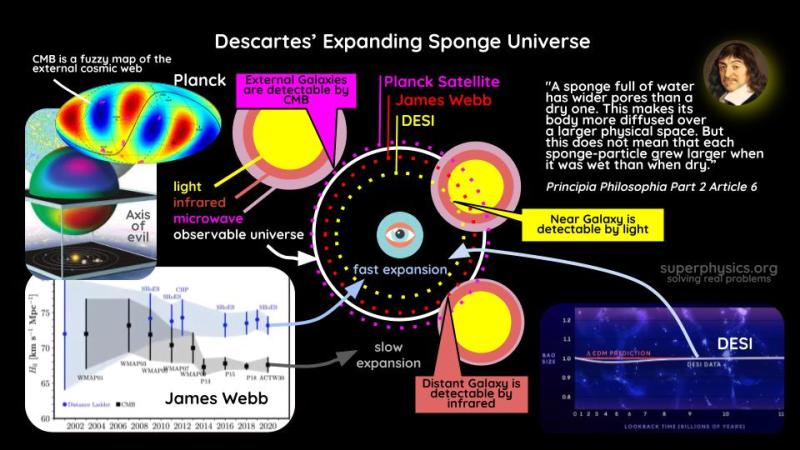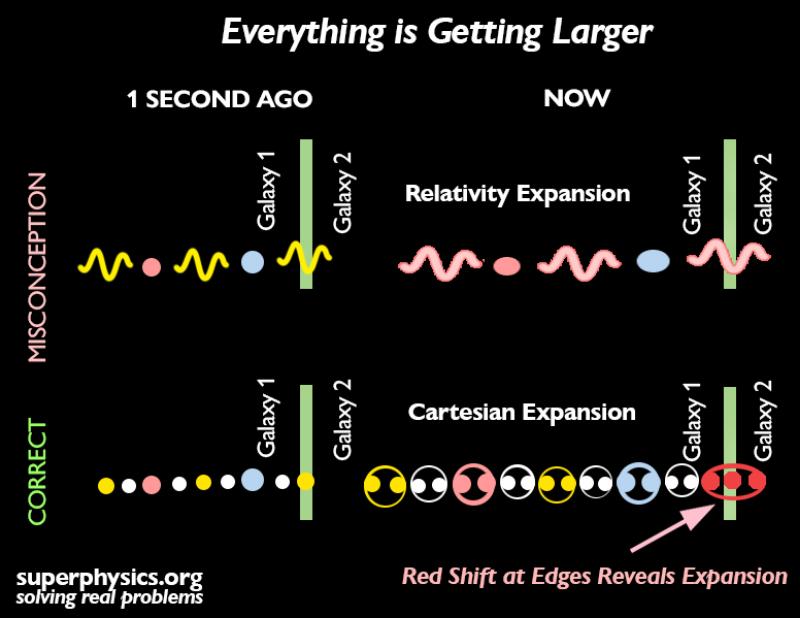Dark Energy: The Expansion of Space-Time
Table of Contents
Material Superphysics explains the large scale phenomena of the universe through the 2 sublayers of the Spatial Layer:
- Spacetime
Unlike the Minkowski spacetime of Physics which has 4 dimensions in a continuum of time, the spacetime of Material Superphysics takes the form of 2-dimensional slices that are separated by the aetherspace.
- The Aetherspace
This is known to Physics as the Planck Length and Planck Time.
While Dark Matter is facilitated by spacetime, Dark Energy is facilitated by the aetherspace.
Expansion from the Aetherspace Splitting Up Spacetime
In Modern Physics, the expansion of the universe is seen through the red shift measured from distant galaxies. This acts like a doppler effect that shows that those galaxies are moving away.
The Hubble and James Webb Space Telescopes measure this with a few galaxies. But specialized telescopes such as DESI measure the red shift from many galaxies for a long time.
This lets them get a bigger data set for the expansion. They found that that the expansion varies and depends on which galaxy cluster you look.
We explain that this is because the mechanism for expansion is in the aetherspace, the same layer that creates spatial vortices called black holes.
The expansion of the universe is dependent on the aethereal mind that observes that universe, being of the same substance as the mechanism of expansion.
- In the prehistoric period, cavemen looked at the stars and saw no expansion
- In the age of telescopes, humans looked at the stars and saw expansion.
- In the age of space telescopes, humans looked at the stars and saw accelerated expansion.
This matches the expansion of the human mind.
- In the prehistoric period, the human mind was not expanded
- In the age of telescopes, it started expanding
- In the age of space telescopes, it started expanding faster
The matter which already fills space G cannot successively fill all the spaces between G and E which are infinitely smaller. Some part of that matter must adapt its shape to the countless measures of those spaces.
To achieve this, all its innumerable particles must be separated from each other by division. This leads to the division of certain particles of matter into infinity, or indefinitely.
Rene Descartes
Principia Philosophia, Part 2 Article 34
The abstract mind expands by “dividing” and analyzing its perceptions. This action (see Chapter 6b) is done through the aetherspace which it imposes onto spacetime.
This is because the aetherspace is ‘alive’ whereas spacetime is ‘dead’.
The dead force, or simple gravitation in a body at rest, produces no observable change and hence no effect. But impact does. Therefore, since forces are proportional to their effects, then dead force is null.
George Berkeley
De Motus, Section 10

Red Shift from Spacetime Edges Show the Expansion
The aetherspace splits up spacetime, causing space to expand while mamtter stays the same.
This phenomenon is exposed by the Radiant Layer as light that produces a red shift when a light-emitting body moves away.
In Material Superphysics, this red shift happens as the edges of the star or galaxy that is sending the light.
A distant body has more red shift the more edges are between it and the observer.

Dark Energy = Gluon Field
The aetherspace in large scale cosmic structures is called by Physics as Dark Energy, whereas the aetherspace in quantum phenomena is called the Gluon Field which binds quarks together in a proton.
Unlike Physics which says that contact forces come from electromagnetic repulsion, Material Superphysics says that it comes from the aetherspace of 2 bodies resisting each other.
In other words, objects cannot occupy the same space because the aetherspace prevents them.
This is why we predict that matter cannot pass through the aetherspace that is between galaxy clusters. Instead, matter needs to teleport from one spacetime to another through the aetherspace, and not linearly through spacetime.
Matter can only travel from one galaxy to another if their spacetimes meet up, such as during galaxy collisions.